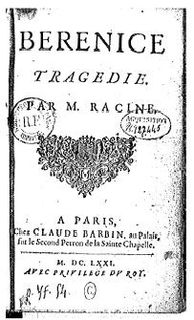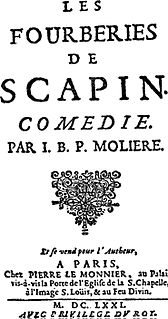Related Research Articles

This article contains information about the literary events and publications of 1670.

Berenice is a five-act tragedy by the French 17th-century playwright Jean Racine. Berenice was not played often between the 17th and the 20th centuries. Today it is one of Racine's more popular plays, after Phèdre, Andromaque and Britannicus.

Tite et Bérénice is a heroic comedy by the 17th-century French playwright Pierre Corneille.

Andromaque is a tragedy in five acts by the French playwright Jean Racine written in alexandrine verse. It was first performed on 17 November 1667 before the court of Louis XIV in the Louvre in the private chambers of the Queen, Marie Thérèse, by the royal company of actors, called "les Grands Comédiens", with Thérèse Du Parc in the title role. The company gave the first public performance two days later in the Hôtel de Bourgogne in Paris. Andromaque, the third of Racine's plays, written at the age of 27, established its author's reputation as one of the great playwrights in France.

Le Bourgeois gentilhomme is a five-act comédie-ballet – a play intermingled with music, dance and singing – written by Molière, first presented on 14 October 1670 before the court of Louis XIV at the Château of Chambord by Molière's troupe of actors. Subsequent public performances were given at the theatre of the Palais-Royal beginning on 23 November 1670. The music was composed by Jean-Baptiste Lully, the choreography was by Pierre Beauchamp, the sets were by Carlo Vigarani and the costumes were done by the chevalier d’Arvieux.

Britannicus is a five-act tragic play by the French dramatist Jean Racine. It was first performed on 13 December 1669 at the Hôtel de Bourgogne in Paris.

Scapin the Schemer is a three-act comedy of intrigue by the French playwright Molière. The title character Scapin is similar to the archetypical Scapino character. The play was first staged on 24 May 1671 in the theatre of the Palais-Royal in Paris.
La Thébaïde is a tragedy in five acts in verse by Jean Racine first presented, without much success, on June 20, 1664 at the Palais-Royal in Paris. The twins, along with their sister Antigone, were children borne of the incestuous marriage of the Theban king Oedipus and his mother Jocasta. The play depicts the struggle and death of the young son of Oedipus, as well as that of Antigone. This subject had already occupied many authors before Racine. Thus, the young playwright, still fairly inexperienced, drew particularly from the Antigone of Sophocles, the Phoenician Women of Euripides, but especially the Antigone of Jean Rotrou and the tragedies of Pierre Corneille.

Monsieur de Pourceaugnac is a three-act comédie-ballet—a ballet interrupted by spoken dialogue—by Molière, first presented on 6 October 1669 before the court of Louis XIV at the Château of Chambord by Molière's troupe of actors. Subsequent public performances were given at the theatre of the Palais-Royal beginning on 18 November 1669. The music was composed by Jean-Baptiste Lully, the choreography was by Pierre Beauchamp, the sets were by Carlo Vigarani, and the costumes were created by the chevalier d’Arvieux.

Les Plaideurs, or The Litigants, written in 1668 and published in 1669, is a comedy in three acts with respectively eight, 14, and four scenes, in alexandrine verse by Jean Racine. It is the only comedy he wrote. It was inspired by The Wasps by Aristophanes, but Racine removed all political significance. His play, which he wrote after Andromaque and before Britannicus, was a farce that, surrounded in his work by tragedies, was unexpected.

Andromède (Andromeda) is a French verse play in a prologue and five acts by Pierre Corneille, first performed on 1 February 1650 by the Troupe Royale de l'Hôtel de Bourgogne at the Théâtre Royal de Bourbon in Paris. The story is taken from Books IV and V of Ovid's Metamorphoses and concerns the transformation of Perseus and Andromeda. The play has rarely been revived and is mostly remembered today for the set of six engravings by François Chauveau depicting the elaborate Baroque set designs of Giacomo Torelli.
La Veuve, ou Le traître trahi is a French verse comedy in five acts by Pierre Corneille, which takes place in Paris. The play was probably first performed early in 1632 by the troupe of Charles Le Noir and Montdory at the Sphère, a rather seedy nightclub in Paris. It was first published in 1634.

The Théâtre de l'Athénée is a theatre at 7 rue Boudreau, in the 9th arrondissement of Paris. Renovated in 1996 and classified a historical monument, the Athénée inherits an artistic tradition marked by the figure of Louis Jouvet who directed the theatre from 1934 to 1951. During the period when he was director, it became known as the Athenée Théâtre Louis-Jouvet.
Play Strindberg is a comedy play by the Swiss writer Friedrich Dürrenmatt, written in 1968 and published in 1969. It is a free adaptation of August Strindberg's The Dance of Death (1900), using Strindberg's characters. The title is a reference to Jacques Loussier's Play Bach series of recordings. The play premiered in Basel on 8 February 1969.

The Théâtre du Palais-Royal on the rue Saint-Honoré in Paris was a theatre in the east wing of the Palais-Royal, which opened on 14 January 1641 with a performance of Jean Desmarets' tragicomedy Mirame. The theatre was used by the troupe of Molière from 1660 to 1673 and as an opera house by the Académie Royale de Musique from 1673 to 1763, when it was destroyed by fire. It was rebuilt and reopened in 1770, but again was destroyed by fire in 1781 and not rebuilt.
Safed Khoon or Safed Khun is an Urdu play by Agha Hashar Kashmiri, based on Shakespeare's King Lear. It was published in 1907.
La Galerie du Palais is a 1632 comedy by Pierre Corneille. The comedy concerns the love relationships of two couples: Lysandre and Celidee; and Dorimant and Hippolyte.
Events from the year 1665 in France.
Events from the year 1670 in France
Stanley Hochman was an editor for several New York City publishing houses and also a translator of European literature and nonfiction. Hochman's final editorial position was as Senior Editor at the former Frederick Ungar Publishing Company, which was acquired by Continuum Publishing in 1985, subsequently absorbed into Bloomsbury Publishing. Earlier in his career, he had held editorial positions at McGraw-Hill, Walker and Company, and several industrial trade magazines.
References
- Hochman, Stanley, editor (1984). McGraw-Hill Encyclopedia of World Drama (second edition, 5 volumes). New York: McGraw-Hill. ISBN 978-0-07-079169-5.